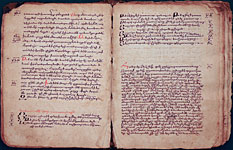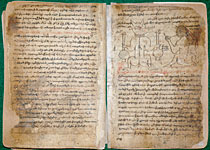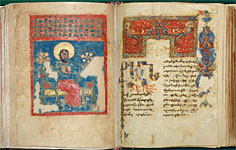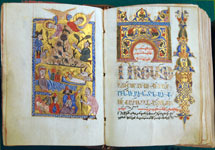Armenian Handwritten Landmarks in the National Library of Russia
O. Vasilyeva
There are not a large number of Armenian manuscripts in the National Library - they amount to little more than a hundred. However, these manuscripts and handwritten documents in the Armenian language are undoubtedly noteworthy for different reasons: for a variety of genres, high equality of book art, a wide time range and geographic coverage, history of their existence and acqisition by the Library.The first Armenian manuscript to enter the Library was a miniature book of collected chants, copied in 1663 in Istanbul. It came in the Imperial Public Library in 1805 together with the items amassed by the Secretary of the Russian embassy in Paris Piotr Dubrovsky whose vast collection became the foundation of the Department of Manuscripts. The Armenian stock was futher supplemented mainly with individual items, with the exception of only one collection. In 1891, the Library received 44 manuscripts from Kamenetz-Podolsk that belonged to the Armenian Catholic Church of this city (Fig.7). The Library continues to acquire manuscripts in the Armenian language; the most interesting recent acquisitions include Sharaknots (Hymnal) - a book of Armenian chants, copied in 1673 and richly decorated with headpieces and initials (Fig.14).
The majority of Armenian manuscripts belong to the category of religious works which includes the Gospels, Psalms, Synaxarions, service books, books of needs, prayer books, collections of sermons, writings of the lives of saints, spiritual poetry, and so on. In addition, there are secular writings. These include Mkhitar Gosh's Code of Laws in the collection dating from 1404 (Fig.5), the Hovhannes Draskhanakerttsi's History of Armenia that ended with his letters written in 1831 in Tbilisi (Fig.17), the Armenian-Kipchak dictionary in the copy of 16th or 17th century (Fig.7), collected works on geographical and astronomical themes (Fig.8), treatises on logic and grammar (Fig.16), as well as works of fiction, for example, the translation from Greek of the Story of Alexander the Great in the copy of 1653 (Fig.15), and much more. Of note too is documentary material such as letters of Armenian Catholicoi to different persons, including the Russian General Pavel Suhtelen who took part in the liberation of Yerevan. (Fig.18).
The oldest manuscripts date from about the 11-12 centuries: these consist of a fragment of Gospels (Fig.1), a leaf of the Gospel of John intended to be placed in the top cover (Fig.2), two leaves from the Life of St. Marina (Fig.3). The earliest date in the manuscripts - 1319 - is recorded in the colophon of the Four Gospels rewritten by Hovseb in Nakhchivan (Fig.4). The Armenian holdings contain a palimpsest, the lower layer of which was written in the Erkatagir (or "ironclad letters") script, probably, in the 11th or 12th century, and the top layer is a collection of various writings dated 1554 (Fig.6) The most recent manuscripts date from the beginning of the 20th century. Among them are Song of the Falcon by Maxim Gorky in translation G. Aykuni, with the dedication to the author (Fig.19).
Very impressive is a range of geographic regions from which books came in the library, that shows the area where the Armenians live. It comprise Echmiadzin and Nihichevan (Fig.4), Istanbul, Amasya and Bitlis (Fig.9), Isfahan, Tbilisi (Fig.17‚Äď18), Lviv and Kamenetz-Podolsk, Feodosiya (Fig.12‚Äď13) and Old Crimea (Solkhat), Venice, Moscow and St. Pererburg.With this temporal and geographical "spread", we should expect a significant diversity in the design of the books, and it is difficult to speak of a single process of development of Armenian book art, although its roots lie in one tradition - the Greek-Byzantine. Yet it is evident that different masters often copied or imitated the earlier samples, giving a unity of appearance to manuscripts created in different places.
This is illustrated with a remarkable example of two books: the Four Gospels which were reproduced and decorated with miniatures by the master Sahak(Isaac) Balishetsi in 1635 in Balesh (Bitlis, Turkey) (Fig.9, 10, 11), and "Sharaknots", copied, decorated and bound by master Nikolaos in 1645 at Kaffe (Feodosiya). (Fig.12‚Äď13). It is surprising that both books are so strikingly similar in their interior design, thin white parchment, and embossed leather-bounding, red edge that it seems they were made in the same workshop.
Researchers of life and works of Nikolaos came to the conclusion that he imitated the earlier samples - the Armenian manuscript of the 13th century Cilician school, available to him. Apparently, the master Sahak Balashetsi, living in Turke, drew its inspiration from the same source.
The Four Gospels was donated in 1887 by well-known collector of Byzantine art A.V. Zvenigorodsky, and "Sharaknots" was presented to the Library Director A.N. Olenin in 1814 by Artemy Bogdanov-Araratsky (Harutyun Valarshapattsi) who accompanied his gift by the following letter:
¬ęYour Excellency
Dear Sir!
Born in ancient Armenia, I had nothing but disasters in my country from childhood to adolescence. Thank to Lord's gracious providence, ... I ... may dwell in the land of promise - Russia! Filled with infinite gratitude to the holy Russian land, ... I wish ... to present a book to the the Public Library of His Imperial Majesty - this is a precious thing for me - and I'm ready to give all my treasures that I have and will have in future.
And this book is called the Sharakan ... or strand of gemstones. It is a liturgic book encompassing prayer hymns and songs of praise for daily church services and all feasts of God and his saints, divided in accordance with the eight modes of Armenian music with notes.
‚ĶThese manuscript was written in town of Kef by the copyist Nikogos the Armenian at request and expense of the priest Terminas, in the year 1093 to the church Armenian calendar, or 170 years before that time, in the reign of the Supreme Patriarch Filippos and Diocesan Head of Kef Archbishop Khachatur. The images of feasts of God and the saints written in gold in it ... , though, are not even of mediocre art, but may deserve respect, because Nikogos learnt to paint and calligraphically write by himself, without any guidance, and he is not obliged to anyone with this but himself. About what he speaks in this book‚Ķ¬Ľ (OR RNB. F. 542 Oleniny. ‚ĄĖ 1028. L. 1-2)
Armenian manuscripts of the Imperial Public Library were described and studied at various times by members of the Academy of Science Marie-Felicite Brosset and Nicholas Yakovlevich Marr. In 2005, the catalogue Armenian Manuscripts in the Collections of St. Petersburg, prepared by Karen Yuzbashyan, appeared. It also reflects the holdings of the Manuscripts Department of the National Library
The exhibition Landmarks of Armenian Culture in the National Library of Russia was held in June 2010 in celebration of the 300th anniversary of the Armenian community of St. Petersburg; and the exposition Russian-Armenian Ecclesiastical Relations was organized in 2012 for the visit of His Holiness Supreme Patriarch and Catholicos of All Armenians Karekin II in Saint Petersburg.









